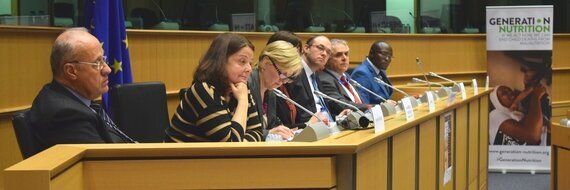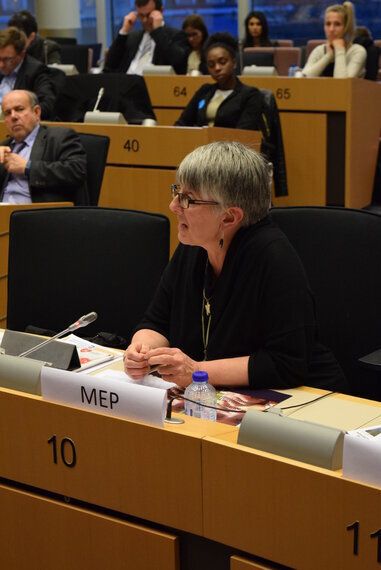
In a few months from now, athletes from around the world will travel all the way to Rio de Janeiro to participate in the Olympics. But the historical games will not be the only protagonists of the hot Brazilian summer. Rio might also become a centre of international cooperation in the fight against malnutrition as, on the eve of the Olympics, world leaders will gather at the "Nutrition for Growth" Summit.
Today, almost 6 million children die every year before they reach the age of five and 45% of these deaths are linked to malnutrition. Malnutrition fuels the cycle of poverty and ultimately impacts economic growth. Despite these worrying figures, nutrition intervention accounts for less than 1% of global development aid. As a co-founder of the intergroup on children's rights in the European Parliament, aiming at mainstreaming the issues of children's rights and well-being in all policy areas, I believe the issue of children suffering from malnutrition and stunting should be a policy priority. In collaboration with the Generation Nutrition campaign, I submitted a written question to the European Commission, asking them about their strategy for nutrition in the context of the Rio summit, to which Commissioner Mimica answered on behalf of the Commission, reaffirming their commitment to fight malnutrition, notably through seeking the alliance of non-traditional donors and emerging economies to join the efforts to fight malnutrition. I will continue to raise awareness around the campaign and support in every way I can as an MEP.

The EU and its Member States remain collectively the world's biggest development aid donor. The European Commission played a strong leadership role in the fight against undernutrition and has adopted several policies on food security and nutrition1. However, this is not enough. Much remains to be done to fill the huge nutrition funding gap.
In numbers: the European Commission committed 3.5 billion € at the first Nutrition for Growth Summit in 2013, in London. Of these funds, 3.1 billion € were allocated to so-called "nutrition-sensitive interventions" (programmes in the agriculture, health or education sectors that aim to prevent malnutrition) while only 0.4 billion € were dedicated to so-called "nutrition-specific interventions" (programmes targeting malnutrition specifically). While both are important, this unbalanced share is representative of the enormous funding gap that exists worldwide for those programmes so essential to address the immediate causes of child undernutrition.
The European Parliament adopted in November 2014 a motion for resolution, prepared by my fellow Labour MEP and Chair for the parliamentary committee on Development, Linda McAvan, calling on all EU and international actors to mobilise long-term financial investments and innovative financing for nutrition.
Several of my fellow MEPs travelled to New York last year, where the brand new Sustainable Development Goals were signed. The second goal promises to end hunger and malnutrition, and as MEPs we intend to hold the EU to its promises. In order to make real progress this year regarding the goal to end hunger and malnutrition by 2030, the Commission should increase its nutrition-specific investments from €83 million a year to €283 million a year until 2020.
Apart from the staggering funding gap, the other thing that struck me about nutrition is how little we know about the way it is funded and the results of this investment. How can we know if we reached Global Goal 2 if information on the key indicators is not regularly collected in a vast number of countries? And how can we know if nutrition-sensitive programmes are leading to improvements when there is no universally applied methodology to report on these investments? The EU can play an important role by improving current tracking of nutrition spending and by supporting better data collection on nutrition outcomes in partner countries.
As member of the FEMM Committee I also like to focus on the specific perspective of women and girls. Although malnutrition's effects on this group have been recognised for decades, there has been little measurable progress in addressing the specific nutritional problems of women and adolescent girls.
Women are more likely to suffer from nutritional deficiencies than men are, for reasons including women's reproductive biology, low social status, poverty, and lack of education.
Sociocultural traditions and disparities in household work patterns can also increase women's chances of being malnourished. Globally, 50 percent of all pregnant women are anaemic, and at least 120 million women in less developed countries are underweight.
Adolescent girls are particularly vulnerable to malnutrition because they are growing faster than at any time after their first year of life.
Addressing women's malnutrition has a range of positive effects because healthy women can fulfil their multiple roles -- generating income, ensuring their families' nutrition, and having healthy children -- more effectively and thereby help advance countries' socioeconomic development. Women are often responsible for producing and preparing food for the household, so their knowledge -- or lack thereof -- about nutrition can affect the health and nutritional status of the entire family. Promoting greater gender equality, including increasing women's control over resources and their ability to make decisions, is crucial. Improving women's nutrition can also help nations achieve three of the Millennium Development Goals2 , which are commonly accepted as a framework for measuring development progress.
When tackling the issue of malnutrition, more consideration should be given to the role of education and intercultural dialogue as a key tool in development, transforming mind-set and addressing key causes of under nutrition. Fighting against malnutrition requires us to ensure access to education -- which must include information on nutrition, and to address social and cultural challenges.
This year affords plenty of opportunities to increase both funding and political will to stop these preventable deaths. This summer I will be watching out, not just for the Olympic teams, but also for how well we score against Global Goal 2 in Rio.
1. European Commission, An EU policy framework to assist developing countries in addressing food security
Challenges, 31 March 2010; European Commission, Enhancing Maternal and Child Nutrition in external assistance: an EU policy framework, 12 March, 2013; European Commission, Nutrition Action Plan, 3 July 2014
2. Promote Gender Equality and Empower Women, Reduce Child Mortality and Improve Maternal Health. More on MDGs here: http://www.un.org/millenniumgoals/
